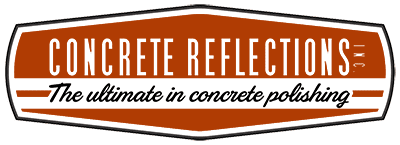Commercial Concrete Polishing
With a modern, attractive design aesthetic and durable, low-maintenance finish, commercial concrete polishing has become a popular flooring option. Like other flooring surfaces, concrete is fully customizable.
A variety of textures and appearances are available to create unique looks for various applications. As a concrete polishing expert that serves many industries and locations, Concrete Reflections is committed to your industrial concrete polishing needs and can apply a range of high-quality finishes to help protect and repel stains and more.
The Process
Polished concrete floors are formed by grinding a concrete slab many times with diamond-grinding tools. Generally speaking, it’s a two-step process.
First, aggressive cutting tools are used to remove imperfections as well as flatten and smooth the concrete surface. The desired finish and quality of concrete mix and pour determines the number of passes. The stone aggregate in the concrete can become exposed during this stage.
Next, less-aggressive diamond tools and are used to boost the concrete surface’s reflectivity. The number of polishing steps depends upon the desired reflectivity level.
Polished concrete appearance
Concrete is a combination of cement and aggregate materials. Aggregates are typically harder than cement to improve wear, and the job location determines the type used. In New York, it’s black or gray granite rock. Limestone is the common aggregate material for Florida.
The Concrete Polishing Council classifies aggregate exposure from A to D, and the amount of exposed aggregate increases as letters change. Here’s a breakdown:
Cream Finish
The Class A category means it has the lowest amount of aggregate exposure. The concrete surface is ground and polished, typically exposing only the sand particles in the concrete floor. This process reveals any imperfections in the original pour. More concrete troweling leads to a more generous cream finish. Cream finishes can be stained any color.
Salt and Pepper Finish
It consists of sand or stone aggregate randomly scattered throughout the finished polished concrete floor. Approximately 1/16-inch of the cream surface is removed by grinding to achieve this look, exposing small amounts of medium aggregate. This finish type has a Class B aggregate exposure level.
Medium Aggregate
Medium aggregate exposure typically reveals the most significant amount of medium aggregate in the concrete floor, with no or little large aggregate exposure at random locations. It has a surface cut depth of approximately 1/8-inch. This finish type carries the Class C aggregate exposure designation.
Large Aggregate
This finish type requires a 1/4-inch surface cut depth and exposes the most amount of large aggregate, which means it has the Class D aggregate exposure designation. This finish is often chosen when the substrate has been seeded with custom aggregate.
Regardless of concrete surface aggregate level exposure, Concrete Reflections can achieve different levels of sheen. This enables you to choose the texture and visual aesthetic that best suits your space.
Polished Concrete Levels
When the grinding, honing, and polishing process is complete, the concrete floor will have a beautiful, and in some cases, shiny or glossy finish. The Concrete Polishing Council classifies concrete polish from 1 through 4, with gloss levels rising as numbers increase.
Gloss values express the degree of reflection when light hits the concrete floor surface. Here’s a polished concrete spectrum to help you determine the best sheen for your concrete floors.
Level 1
With less than 100 grit, there’s zero to very low sheen. Floors with this gloss level appear flat and have little if any reflectivity.
Level 2
With between 200 and 400 grit, there’s a low to medium sheen. Floors with this gloss level have a satin or matte finish and a diffused amount of reflection.
Level 3
Floors with this gloss level have a semi-polished appearance, which means objects reflected are easily identifiable but not quite sharp and crisp. The grit level is 800 or higher.
Level 4
The grit level is 1500 or higher. To achieve this clarity level, two to three passes of grinding, honing, and polishing are required for the resin to pop. Once completed, objects reflected are sharp and crisp. These are highly polished floors with a mirror-like clarity.
More Than Just Polishing
Concrete Reflections recommends the application of an impregnator when polishing concrete polishing for specific applications. These oil-based products protect concrete slabs from defects and resist moisture, stains, and mildew. A repellent may also be used before staining to assist with easy clean up.
Additionally, we can also apply Ameripolish dyes to your concrete floor. Available in a variety of colors, they add flair but fade with exposure to ultraviolet light.
The Concrete Floor Polishing Experts
No matter the aggregate exposure or gloss amount needed, Concrete Reflections is your concrete floor source. Experience, innovative equipment, and a quality-first mindset enable us to install top-quality concrete floors for various commercial and industrial uses.
- Automotive
- Aviation
- Distribution Centers
- General Contractors
- Government Buildings
- Laboratories and Medical
- Manufacturing Facilities
- Retailers
- Warehouses
At Concrete Reflections, client satisfaction is our utmost priority. We can help you find concrete floor finishes that match your taste and functionality goals. Our expert team ensures the job is done right, quickly, and within budget.
Contact us to learn more about concrete polishing finishes.
